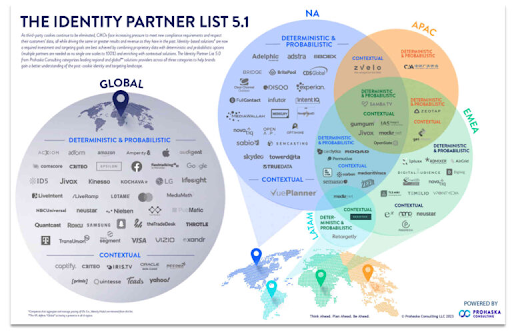
If it feels like everyone in ad tech is pitching an identity solution for a post-identity world, it’s because they are.
But the identity conversation is loaded with BS because everyone talks about it like they know what the future holds. Worse, they’re presenting solutions based on what they “know.”
In reality, nobody knows what a post-identity world will actually look like because that world is still largely hypothetical. And because there is no “right” answer to what the world will look like, there are gazillions of “answers” masquerading as solutions!
That doesn’t mean these solutions are terrible and won’t work, it’s just important to recognize that they’re built on an assumption that certain hypotheses will come true when those hypotheses could easily turn out to be wrong.
What we do know is that the post-identity world will be shaped by developments in three arenas: regulatory policies for privacy, platform decisions around consumer data, and consumer sentiment. Each arena has complicated dynamics, but the picture becomes even more complex when you try to predict how it all fits together. In other words, a perfect storm for BS.
Let’s do a quick reality check on each arena to understand why it’s impossible, at the moment, to settle on a vision for a post-identity world.
Do you know where privacy regulation will land? I don’t.
Privacy regulation has been the elephant in the room throughout the history of ad tech. A few years ago, the elephant woke up and gave us GDPR. But remember, the first proposal for GDPR was in 2012.
It took six years and countless twists and turns before GDPR took effect in 2018. But that was just one privacy law in one region. Similar efforts in the U.S. and elsewhere have taken even longer to materialize. If the rest of the world catches up to the EU, there’s no telling how regional rules will come together to govern the global internet. Will IP be considered PII? Will first-party data be viewed like third-party data? Will companies be able to use encrypted email addresses? Will there be limitations on fingerprinting?
Ad tech vendors and marketers are stuck planning for a future where it’s impossible to say what the rules of the road will be, or which players will have a hand in setting those rules.
Do you know what the platforms will do next? I’ve heard rumors.
Compared to what we see on the public policy front, the big tech platforms move fast and break things like third-party cookies, device IDs, and other signals that ad tech relies on. In some ways, the pace of change is a blessing because speed creates an urgency to prepare for the future.
The trouble is, the platforms aren’t going to show us their plans, and unlike the regulatory process, there’s no mechanism to force transparency. Oh, and they have ulterior motives.
But it’s not as if the blueprint for the future is under lock and key inside Apple or Google. The platforms also face uncertainty because they need to balance the competing priorities of regulatory demands, positioning their brands for a privacy-conscious marketplace, and their advertising businesses.
In other words, it’s complicated. And while the trade press works hard to chase down rumors, there just isn’t enough solid information yet for marketers and ad tech vendors to act with certitude. Just look at Google. They literally change course on privacy weekly.
Are consumers on board with this? Unclear.
A decade ago, the Web was wide open and consumers weren’t terribly concerned with privacy. Today, walled gardens are ascendent, fragmentation is increasing, and a critical mass of consumers aren’t just concerned about privacy, they’re taking action by using ad blockers, adjusting their privacy preferences, and even paying for content with fewer (or zero) ads. We can thank Cambridge Analytica, Apple’s heavily-funded privacy ad campaigns, and The Social Dilemma for that.
These developments represent significant risk to the value exchange at the center of the current model. But if it took 20-plus years for that value exchange to come together, why would we expect the next iteration of the value exchange to mature overnight? If anything, we’re at the start of an ongoing conversation where consumer sentiment and subsequent demands are a moving target.
How should we think about identity in the face of uncertainty?
Roll up the uncertainties around regulation, platforms, and consumer sentiment, and you see the challenge. We face countless variables, a wide range of hypotheses, and for each hypothesis, a corresponding solution. Prohaska Consulting & the MMA’s most recent count found more than 120 identity solutions across the globe – with more on the way.
So how do marketers and publishers future-proof their operations? Do you bet on a probabilistic solution? A deterministic one? Or, is the future a throwback to the days of contextual advertising?
Here’s a better question: do you know what any of that means? Do you understand how it all differs, how it’s similar, how it can all work together, how it can be done today, and how it might need to be done in the future? Could you explain it to a friend who doesn’t work in digital? Would you feel confident explaining it to your boss and running point on making strategic decisions on identity?
If your answer is ‘no’, that’s okay, you’re not alone. Pretty much everyone is in this boat. A good place to start is to educate yourself. All identity solutions have trade-offs, and no single solution is perfect. But if you understand the methodologies, applications, and commercial constraints of identity solutions, you’ll be able to understand those trade-offs and be better equipped to make decisions based on your hypotheses.
Equally important, the more marketers and publishers know about the strengths, weaknesses, and blindspots of the next generation of identity solutions, the more likely they are to build resilient systems and strategies for any future scenario. But it all starts with education, not a BS conversation.
To learn more about this topic, check out Shiv Gupta’s keynote — Calling BS on Identity: An In-depth Guide to Identity Solutions — at AdMonsters Ops on June 5, 2023.



